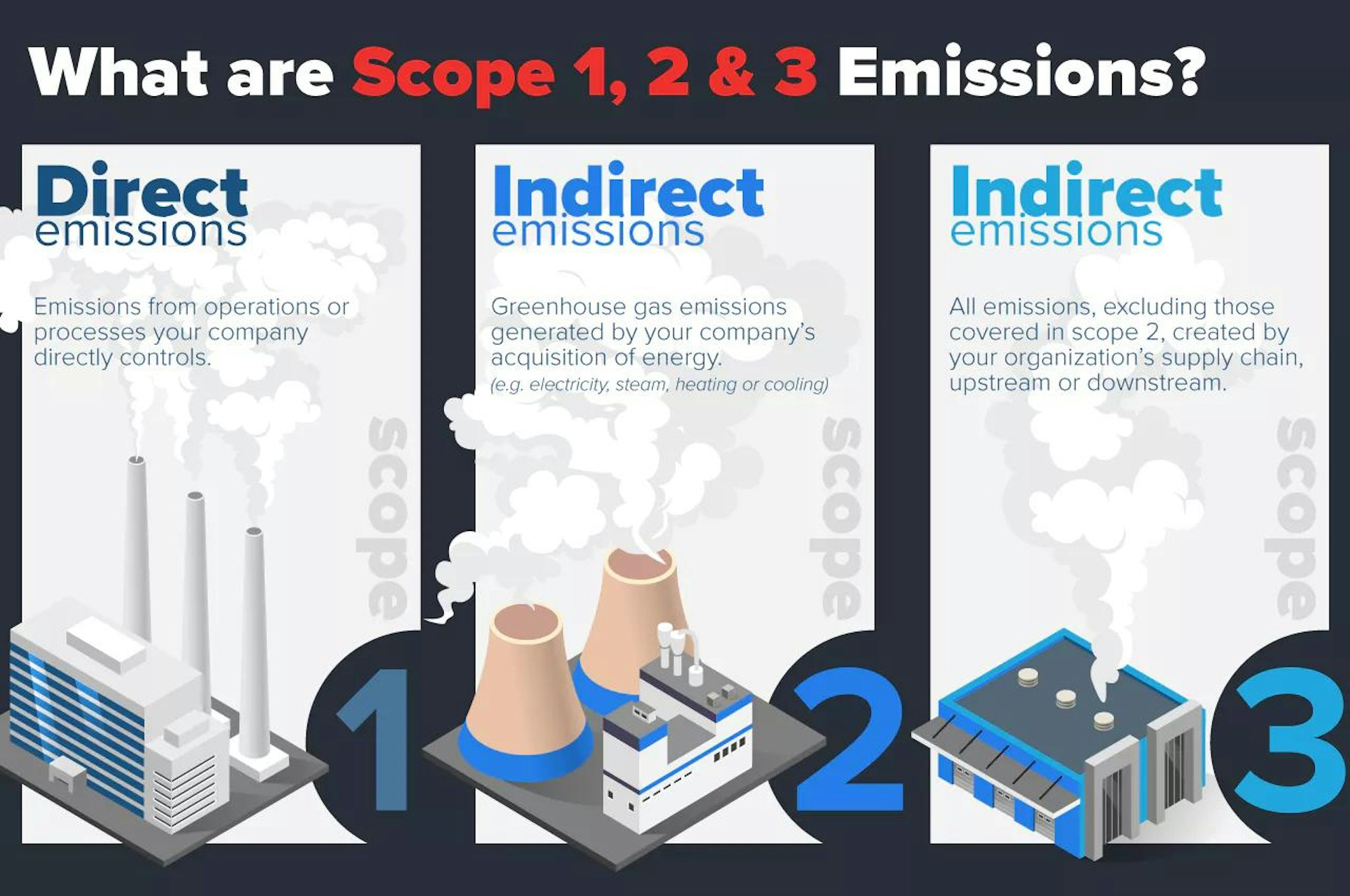Tackling scope 1, 2 and 3 emissions within your climate reporting

Regardless of whether or not it’s mandated by regulation, organizations realize the importance of measuring their greenhouse gas (GHG) emissions. If this is something you’re prioritizing, you will probably be familiar with the concept of Scope 1 2 3 emissions.
But what do Scope 1, 2 and 3 emissions mean in practice? What are the differences between each, and how should your approach to measuring each differs? Where should you focus your efforts if you’re just starting out on environmental, social and governance (ESG) reporting?
What Are Scope 1, 2 and 3 Emissions?
Measuring your greenhouse gas emissions demands that you understand the three different areas, or scopes, you need to capture. Scope 1 2 3 emissions were defined by the GHG Protocol in 2001; today, more than 9 out of 10 Fortune 500 companies reporting to CDP (the not-for-profit charity that runs the global disclosure system on environmental impacts) use the GHG Protocol.

Scope 1 and 2 emissions form part of mandatory greenhouse gas emission reporting in many countries. They relate to emissions the company directly ‘owns’ or uses.
Scope 3 emissions are more complex to capture; they cover all emissions that the company is responsible for throughout its entire value chain or supply chain. As you can imagine, these can be more difficult to collect data on, quantify and report on with confidence.
Partly because of this complexity, Scope 3 emissions reporting remains largely voluntary. Although, as we know, ESG is a fast-moving area, with no guarantee that the climate imperative may not drive stricter legislation here before too long.
Scope 1, 2, 3 Emission Examples
Whether or not you’re required by law or regulation to measure your greenhouse gas emissions, it’s increasingly vital that you do so. Some companies are motivated by the “stick” of potential new legislation and the consequences of non-compliance; others by the “carrot” of being well-prepared to face whatever regulatory requirements materialize.
Whatever drives your efforts to measure scope 1 2 3 emissions, there’s a clear recognition that proactivity around ESG and climate can be good for business. And conversely, that falling behind on climate imperatives comes at significant commercial cost.
If you’re finding greenhouse gas emissions reporting overwhelming, consider this: the first step to getting on the front foot is making a start.
If you’re just setting out on ESG reporting, focus first on scope 1 and 2 emissions. Build a strong foundation by getting to grips with scopes 1 and 2 — where you are likely to be in control of the data, and have easier access to it — before you move on to the more complex scope 3. The key thing is taking a step in the right direction.
To take this first step and understand how to tackle scope 1, 2 and 3 emissions, we need clarity on what emissions fall into each category.
What are Scope 1 Emissions?
Scope 1 emissions are the emissions your company makes directly. Those produced by heating your worksite or the emissions from your fleet of vehicles are considered Scope 1 emissions.
What are Scope 2 Emissions?
Scope 2 emissions are ones your business makes indirectly. They're associated with the greenhouse gases created during the production of your acquired energy.
Examples of scope 2 emissions include the emissions generated in the production of the oil you use to heat your buildings or the diesel you use to power your delivery vehicles.
What are Scope 3 Emissions?
Scope 3 carbon emissions are by far the most complex. Scope 3 emissions cover any emissions your organization is indirectly responsible for across your entire supply chain. Not surprisingly, this makes scope 3 emissions the most difficult to measure. Data is complex, multi-faceted, challenging to collect, and relies on parties outside your control; data capture can be a massive challenge without visibility along your entire supply chain.
As a result, scope 3 emissions is the area most organizations tackle after they have mastered scope 1 and 2 emissions reporting. It’s also the last area many regulators mandate disclosures, with regulatory bodies, including the SEC, recognizing the need for businesses to master the foundations of climate reporting before moving on to the more significant challenges.
The scope 3 emissions definition is the most complex. These emissions cover those throughout your entire value chain: emissions produced when buying products from your suppliers or via your products being used by customers.
Tips and Key Pointers on GHG Emissions
So, if you’re making a start on greenhouse gas emissions reporting or advancing your approach from scopes 1 and 2 to scope 3 emissions, what does best practice look like? What are the tips and pointers that can help you to achieve success efficiently and effectively?
- Start with the areas within your control. We’ve said this before, but it’s worth repeating. Scope 1 and 2 emissions are the most straightforward to measure. They’re the emissions you are likely to have clear data on in-house or where data is easily obtained from your direct suppliers.
- Involve the relevant internal teams: facilities and estates; procurement; the finance function; compliance, and you should be able to measure and report on your scope 1 and 2 emissions.
- Be ambitious in your scope 1 and 2 emissions plans. These are where you can find “quick wins” in your attempts to shift the dial on net zero. It’s within your gift, for example, to seek out renewable providers for your energy use. You may also be able to influence your direct suppliers. Don’t underestimate the changes your focus on scope 1 and 2 emissions could drive.
- It’s sensible to start with scopes 1 and 2 — but don’t neglect scope 3 emissions. While scope 3 is the most complex area of emissions to capture data and report on, it’s also the area where you can have the most impact. Research by the Carbon Trust shows that Scope 3 emissions represent between 65% and 95% of the total carbon impact for most companies.
- The comparative lack of control over scope 3 emissions, though, can make it a challenge. But as a purchaser, you have the potential to sway the decisions made by your suppliers; use this influence to help drive the carbon-neutral agenda.
- Your supply-chain and third-party risk management approaches should include collaboration to reduce greenhouse gas emissions along the entire value chain, driving mutually-beneficial ESG strategies for you and your suppliers.
- Because of the enormous impact your scope 3 emissions can have, scope 3 can be the lynchpin of your net-zero commitments. Another good reason not to relegate scope 3 emissions to the “too difficult” pile once you have cracked scope 1 and 2 emissions reporting.
You can’t reach net zero, or even make significant strides towards it, without being able to identify all the carbon emissions within your sphere of influence. Tackling scope 3 emissions is key to this.
Measure Your Greenhouse Gas Emissions to Comply With Growing Requirements
As climate-related reporting becomes more prevalent, the need to measure and evidence greenhouse gas emissions grow more pressing. Additionally, businesses are increasingly recognizing not just the compliance and reputational benefits of adopting proactive ESG strategies but also realizing that there can be a real business cost of failing to prioritize net zero.
Any organization not already reporting on climate data needs to make an urgent start, as new climate disclosure proposals — like that passed by the SEC in March 2022, which includes requirements around emissions in scope 1, 2 and some of 3 — compel businesses to comply.
The good news is that Diligent’s approach and solutions allow you to jump right in where you are — whether you are at the start of your climate disclosure journey or well-established and advancing towards comprehensive scope 3 emissions reporting.
If you want to learn more about scope 1, 2 and 3 emissions, you can read more in our blog, How to Measure Greenhouse Gas Emissions, which goes into detail on some of the challenges in measuring GHG scope 1, 2 and 3 emissions and how to overcome them.